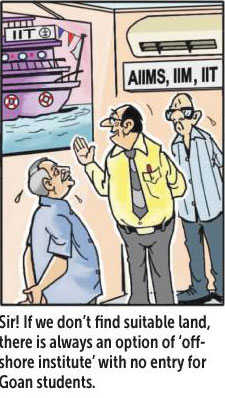Sujay Gupta
The relentless grind of the highway from Panjim to Mapusa often
eludes our fine senses. But once in a while, if the grind can be paused and the
wanderings of soul are followed, your path may take a slight bend at the high
mast before Guirim and turn towards Socorro.
If there was a resistance movement of Goa’s villages against
invaders and intruders converting villages into concrete monstrosities, Socorro
would have been in the forefront and won. And it indeed has. Leafy swaying
roads lined with villas and haciendas, Socorro could be coastal Spain and
Mexico rolled into one. But old timers will say that it’s well and truly Goan,
the Goa which was and the Goa which is meant to be.
It’s such a leitmotif of tradition and preservation. And
that extends from the homes to the Socorro Church and its vast grounds which are
used by a group of young men and women dedicated to the cause of preserving
Goa’s traditions with a zeal which is truly missionary. But if there’s a
shepherd of this movement, it’s Marius Fernandes, the London returned, Divar
based crusader. The speed at which he is organising a series of traditional
Goan fests in a gorgeous assembly line, is bringing in its wake a wave of
followers who see them as a festivals of togetherness. For the children these
fests are a picnic with valuable insights into Goan musical instruments,
ceramics, handicrafts, weaving and so on. For elders and those in their sunset
years, these are sights that they grew up seeing, a delirious de ja vu. If the
ghumot, an instrument which was in the verge of extinction has been revived, it
is due to the efforts of Marius, Prajal Sakhardande, Carlos Gonsalves and others
who are partners in this ongoing mission of preservation.
At the Pattoleanchem Fest last Sunday, we met two stand-out creative
artists. Shruti Mascarenhas, who lives behind the Socorro church and does
ceramic art with vivacity and colour seldom seen and the specially abled polio
stricken and wheel chair bound Premanand Satarkar, who lives in the woods of
Keri and makes musical instruments, from the bamboo found in the forests. On display
was a guitar, a harmonium and other instruments from plain Goan bamboo. If this
is not indigenous art, then what is?
Last week’s Pattoleanchem Fest will be followed by this
Sunday’s ( today’s) upcoming Moll'lachem Fest at the Socorro church. Marius has
tapped into a data base of artists who will showcase their work today and
though we have reported this it needs reiteration because describing the work
of Marius and his team is never enough. The fest will dwell on the art of weaving
and ‘Rotesao’. Philu D’Souza will demonstrate weaving techniques and the most
difficult part of finishing the knot. Josefa Roberts and Aurora Lobo will
demonstrate and spot train enthusiasts on chair weaving, Annu Surya Dargalkar will
weave baskets and Augustine Fernandes will teach youngsters to peel a coconut
with only the koito.
These are the soldiers of Goa’s future, wielding two
timeless weapons of Goa’s past, tradition and love. From Socorro, the fest
brigade heads to Arambol for the Ramponnkaranchem Fest on August 27, of
traditional fishermen, where music, song and food from the heaven’s will be on
display.
An intrinsic and seamless given in each of these festivals
is the abundance of absolutely traditional cuisine, made at home by families,
who cook for the love of cooking and feeding, a feeling which germinates in the
womb and passes in to the grave of most mothers, sisters and aunts. They are
born to feed and the curries, the vegetables and the sweets that emerge during
these fests, are irreplaceable and impossible to clone by any restaurant. Last
Sunday after huge helpings of lunch served on a traditional leafy plate, we stood
in line to be served the traditional desert, Vonn, served in coconut husks. Drunk deliciously warm, Vonn is made of coconut milk, maida
flour, channa dal, palm jaggery (maad gudd), and cardamom. Yours truly had two
of those, standing on the edge of the Church cemetery looking into the expanse
of colour, with two massive ghumots placed in the centre of the field. Families
milled around, friends shouted greetings, there was song and music and shrieks
of laughter. These were delirious joys of reliving and reexperiencing the Goa
which we hope we have not left behind.
And hopefully each day, as we remember these fests, there will be a fest in each of our homes, as we wake up to realise what a blessed land we live in.
